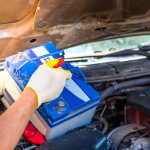Welcome to our comprehensive guide on the Ford Power Stroke Diesel Engine! Whether you’re a seasoned diesel enthusiast, a Ford truck owner, or simply curious about what makes these engines tick, you’ve come to the right place. The Power Stroke line has built a reputation for performance, reliability, and innovation, powering everything from heavy-duty work trucks to personal vehicles.
In this article, we’ll dive deep into everything you need to know about these impressive engines, including their history, specifications, maintenance tips, and troubleshooting advice. With a friendly and informative tone, we hope to arm you with the knowledge to appreciate, maintain, and get the most out of your Power Stroke diesel. Let’s rev up and explore the world of Ford Power Stroke engines together!
Understanding the Ford Power Stroke Diesel Engine: A Comprehensive Overview
The Ford Power Stroke Diesel engine has become synonymous with performance and reliability in the world of heavy-duty trucks. First introduced in 1994, this engine series has undergone numerous innovations and improvements over the years, making it a popular choice among truck enthusiasts and professionals alike. With its robust design and advanced technology, the Power Stroke engine delivers impressive torque and horsepower, essential for towing and carrying heavy loads. Key features include:
Turbocharging – Enhances air intake for improved combustion efficiency.
Intercooling - Lowers air temperature for denser air, increasing power output.
Fuel Injection System – Provides precise control over fuel delivery, ensuring optimal performance across various driving conditions.
Over the years, Ford has introduced several iterations of the Power Stroke, each with its own unique specifications and enhancements. The latest models boast advanced technologies such as the Ford EcoBoost system, which optimizes fuel efficiency without compromising power. Below is a simplified comparison of some prominent Power Stroke engines:
| Engine Model | Displacement | Horsepower | Torque |
|---|---|---|---|
| 7.3L Godzilla V8 | 7.3 liters | 430 hp | 475 lb-ft |
| 6.7L Power Stroke V8 | 6.7 liters | 475 hp | 1,050 lb-ft |
| 5.0L Power Stroke V8 | 5.0 liters | 270 hp | 660 lb-ft |
Key Features and Innovations of the Power Stroke Diesel Engine
The Ford Power Stroke diesel engine stands out due to its robust engineering and cutting-edge technology, making it a popular choice for truck enthusiasts and heavy-duty applications. Some of its key features include:
Turbocharged Performance: The turbocharger enhances power output while maintaining fuel efficiency, allowing for impressive towing capacities and acceleration.
Advanced Fuel Injection: Utilizing common rail direct fuel injection, the engine delivers precise fuel atomization, resulting in improved combustion and reduced emissions.
Durability: Constructed with high-strength components and a reinforced engine block, Power Stroke engines are designed to withstand demanding conditions and extended use.
EcoBoost Technology: Certain models incorporate EcoBoost features for maximized fuel economy and reduced carbon footprint, proving that power doesn’t have to come at the expense of efficiency.
Another significant innovation is the seamless integration of smart technology aimed at enhancing performance and user experience. This includes:
- Adaptive Cruise Control: Helps in maintaining a safe distance from vehicles ahead, especially useful during long hauls.
- Onboard Diagnostics: Provides real-time feedback on engine performance and alerts drivers of potential issues before they escalate.
- Variable Geometry Turbocharger (VGT): Adjusts turbine geometry for optimal spool-up response across a wide range of RPMs, enhancing drivability.
| Feature | Description |
|---|---|
| Turbocharged Performance | Increases power and efficiency for heavy-duty performance. |
| Durability | Engine components are built to last under extreme conditions. |
| Smart Technology | Innovative features improve driver safety and engine management. |
Maintenance Tips for Longevity and Performance Enhancement
To ensure your Ford Power Stroke diesel engine delivers peak performance over time, regular maintenance is essential. Start with oil changes every 5,000 to 7,500 miles using high-quality diesel engine oil. This helps in lubricating moving parts and reducing friction. Additionally, keep an eye on the fuel filter; replacing it every 10,000 miles can prevent contaminants from clogging your fuel system. Maintaining clean air filters also boosts engine efficiency and improves fuel economy, so check and replace them every 15,000 miles as needed.
Another crucial aspect of maintenance is monitoring the cooling system. Ensure your coolant levels are adequate and replace the coolant every 50,000 miles to prevent overheating. Pay attention to the transmission fluid as well; changing it every 30,000 miles can enhance transmission performance and longevity. conduct regular inspections of the exhaust system for leaks and damage, as a well-functioning exhaust is vital for optimal engine output.
Choosing the Right Power Stroke Configuration for Your Needs
When it comes to choosing the right Power Stroke configuration, it’s essential to consider how you plan to use your vehicle. Different configurations cater to varied needs, such as towing capacity, fuel efficiency, and overall performance. For instance, if you’re in the market for a truck primarily for heavy towing, opting for a larger displacement engine with higher torque may be beneficial. On the other hand, if you’re looking to enhance fuel economy and daily drivability without demanding extreme power, a smaller configuration might suit you better.
Here are a few key factors to weigh in your decision:
Towing Requirements: Assess the weight and type of loads you’ll be hauling.
Driving Environment: Consider whether you’ll mostly be on highways, city roads, or off-road.
Maintenance Costs: Evaluate long-term maintenance based on engine size and parts availability.
Fuel Type: Determine if diesel or biofuel options align with your preferences.
| Configuration | Towing Capacity | Fuel Efficiency |
|---|---|---|
| 6.7L Power Stroke | Up to 37,000 lbs | 20-25 MPG |
| 7.3L Gas | Up to 19,000 lbs | 12-16 MPG |
| 6.2L V8 | Up to 15,000 lbs | 13-18 MPG |
Q&A
Q&A: Ford Power Stroke Diesel Engine Guide – Everything You Need to Know
Q1: What is the Ford Power Stroke diesel engine?
A1: The Ford Power Stroke is a series of diesel engines produced by Ford Motor Company specifically for their trucks and larger vehicles. These engines are renowned for their robust performance, exceptional towing capabilities, and efficiency, making them a popular choice among truck enthusiasts and fleet operators alike.
Q2: What are the different generations of Power Stroke engines?
A2: The Power Stroke engine lineup has evolved through several generations, starting with the first generation introduced in 1994. Key generations include:
- 1st Generation (1994-1997): 7.3L V8, known for its reliability.
- 2nd Generation (1999-2003): Updated to a 7.3L turbocharged V8 with improved performance.
- 3rd Generation (2003-2007): 6.0L V8, faced some reliability issues but offered more power.
- 4th Generation (2008-2010): 6.4L V8, featuring advanced technology for better emissions control.
- 5th Generation (2011-2016): 6.7L V8, with significant improvements in power and fuel economy.
- 6th Generation (2017-Present): Continuing to refine the 6.7L V8, incorporating even more technological enhancements.
Q3: What are the key features of the 6.7L Power Stroke engine?
A3: The 6.7L Power Stroke engine is known for its impressive features, including:
- High Torque: Delivers exceptional low-end torque, ideal for heavy hauling.
- Turbocharging: Utilizes a twin-scroll turbocharger for improved throttle response.
- Fuel Efficiency: Designed to optimize fuel economy without sacrificing power.
- Advanced Technology: Incorporates features like variable geometry turbos and intercoolers for enhanced performance.
- Durability: Built with robust materials to withstand the demands of heavy-duty use.
Q4: What are some common issues with Power Stroke engines?
A4: While the Power Stroke engines are generally reliable, some models, particularly the 6.0L, have encountered issues such as:
- EGR Cooler Failures: Can lead to coolant leaks and overheating.
- Head Gasket Failures: Especially in high-performance scenarios.
- Fuel Injector Problems: Issues can arise from dirt or improper maintenance.
Regular maintenance and addressing issues promptly can help mitigate these problems.
Q5: How can I maintain my Power Stroke diesel engine?
A5: To keep your Power Stroke diesel engine running smoothly, consider the following maintenance tips:
- Regular Oil Changes: Use high-quality diesel engine oil and change it per manufacturer guidelines.
- Fuel System Maintenance: Keep the fuel system clean by using quality fuel and adding fuel additives as needed.
- Check Filters: Regularly inspect and replace air and fuel filters.
- Monitor Exhaust System: Ensure the exhaust system is functioning properly to avoid performance issues.
- Stay on Top of Software Updates: Modern engines often have software that can be updated for performance improvements.
Q6: Are Power Stroke engines good for towing?
A6: Absolutely! Power Stroke engines are designed with towing in mind. With their high torque and horsepower ratings, they excel in hauling heavy trailers, boats, and other loads, making them ideal for both work and recreational use. Always check the specific towing capacity for your vehicle model to ensure safe hauling.
Q7: What should I consider when buying a used Power Stroke truck?
A7: When purchasing a used truck with a Power Stroke engine, consider:
- Service History: Look for records of regular maintenance and any repairs.
- Engine Condition: Inspect for leaks, smoke, or unusual noises during a test drive.
- Mileage: Higher mileage can indicate wear, so it’s important to assess how the truck was used.
- Model-Specific Issues: Research common issues related to the specific generation of the engine.
By taking these factors into account, you can make a more informed purchasing decision.
Q8: Where can I find more information about Power Stroke engines?
A8: For more in-depth knowledge, consider visiting official Ford websites, owner forums, and dedicated diesel performance websites. Many enthusiasts and experts share tips, tricks, and troubleshooting advice that can be incredibly helpful for both new and experienced owners.
We hope this guide provides you with valuable insights into the Ford Power Stroke diesel engine! If you have any other questions or need further assistance, feel free to reach out to your dealer or local automotive expert. Happy driving!
Final Thoughts
the Ford Power Stroke Diesel engine stands as a testament to innovation, power, and reliability in the world of heavy-duty performance. Whether you’re a seasoned diesel enthusiast or a newcomer eager to learn, understanding the nuances of this remarkable engine can significantly enhance your driving experience and maintenance approach. From its robust design to its impressive towing capabilities, the Power Stroke is more than just an engine; it’s a promise of endurance and efficiency.
We hope this guide has equipped you with valuable insights and practical knowledge to help you make the most of your Power Stroke experience. Remember, regular maintenance and proper care are key to unlocking the full potential of your engine. As you embark on your journey with Ford Power Stroke, stay curious, keep learning, and enjoy every mile!
Thank you for joining us in exploring the world of Ford Power Stroke Diesel engines. If you have any questions or want to share your experiences, feel free to reach out in the comments below. Safe travels!











